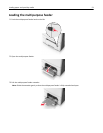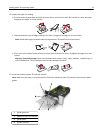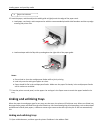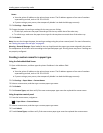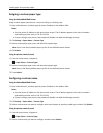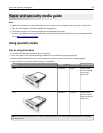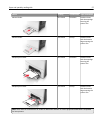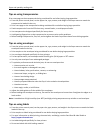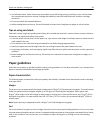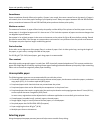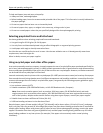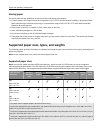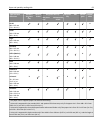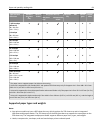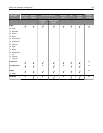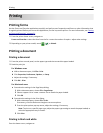
• Use full label sheets. Partial sheets may cause labels to peel off during printing, resulting in a jam. Partial sheets
also contaminate the printer and the cartridge with adhesive, and could void the printer and toner cartridge
warranties.
• Do not use labels with exposed adhesive.
• Before loading labels on the tray, flex and fan labels to loosen them. Straighten the edges on a level surface.
Tips on using card stock
Card stock is heavy, single‑ply specialty media. Many of its variable characteristics, such as moisture content, thickness,
and texture, can significantly affect print quality.
• From the printer control panel, set the paper size, type, texture, and weight in the Paper menu to match the card
stock loaded in the tray.
• Print samples on the card stock being considered for use before buying large quantities.
• Specify the paper texture and weight from the tray settings to match the paper loaded in the tray.
• Preprinting, perforation, and creasing may significantly affect the print quality and cause jams or other paper feed
problems.
• Before loading the card stock on the tray, flex and fan the card stock to loosen them. Straighten the edges on a
level surface.
Paper guidelines
Select the correct paper or specialty media to reduce printing problems. For the best print quality, try a sample of the
paper or specialty media before buying large quantities.
Paper characteristics
The following paper characteristics affect print quality and reliability. Consider these characteristics when evaluating
new paper stock.
Weight
The printer trays can automatically feed paper weights up to 176‑g/m
2
(47‑lb) bond grain long paper. The multipurpose
feeder can automatically feed paper weights up to 176‑g/m
2
(47‑lb) bond grain long paper. Paper lighter than
60 g/m
2
(16 lb) might not be stiff enough to feed properly, causing jams. For best performance, use 75‑g/m
2
(20‑lb)
bond grain long paper. For paper smaller than 182 x 257 mm (7.2 x 10.1 inches), we recommend 90 g/m
2
(24 lb) or
heavier paper.
Note: Duplex printing is supported from 60–105‑g/m
2
(16–28‑lb) bond grain long paper.
Curl
Curl is the tendency for paper to curl at its edges. Excessive curl can cause paper feeding problems. Curl can occur after
the paper passes through the printer, where it is exposed to high temperatures. Storing paper unwrapped in hot, humid,
cold, or dry conditions, even in the trays, can contribute to paper curling prior to printing and can cause feeding
problems.
Paper and specialty media guide 59



